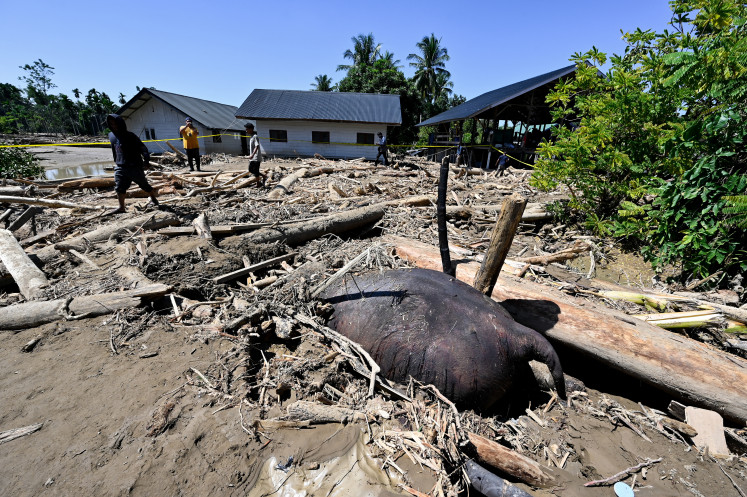Popular Reads
Top Results
Can't find what you're looking for?
View all search resultsPopular Reads
Top Results
Can't find what you're looking for?
View all search resultsUnique features of Islamic finance development
Islamic finance is one of the fastest growing segments in the financial services industry, both in size and number
Change text size
Gift Premium Articles
to Anyone
I
slamic finance is one of the fastest growing segments in the financial services industry, both in size and number. According to the Economist magazine (September 2014), Islamic finance grew at an annual rate of 17.6 percent between 2009 and 2013, faster than conventional banking and is estimated to be US$2 trillion in size. However, one of the puzzles of Islamic finance development is how Indonesia, the country with the biggest Muslim population in the world, has been left behind its development.
One of the reasons why the development of Islamic finance in Indonesia is being left behind can be seen from its historical profile. Despite its huge Muslim population, Indonesia is a relative latecomer to the Islamic finance industry.
The United Arab Emirates has a head start in Islamic finance of about 20 years, as it established the first modern commercial Islamic bank, Dubai Islamic Bank, in 1979. Malaysia started to be involved with the Islamic financial system when it introduced the Malaysian Pilgrims Fund Board (Tabung Haji) in 1963. The first Islamic bank in Malaysia, Bank Islam Malaysia Berhad (BIMB), started to operate in 1983.
On the other hand, the first Islamic financial institution arrived somewhat later in Indonesia than in other Muslim-majority countries, for under the New Order of the Soeharto administration, Islamic finance, like any other conspicuously Islamic behavior, was linked to radicalism and extremism. The first Indonesian Islamic bank, Bank Muamalat Indonesia, was established in 1992 and Bank Indonesia was only allowed to make use of Islamic instruments as part of its monetary policy in 1999.
The other argument for the late development of Islamic finance in Indonesia also can be seen from a new institutional economics perspective, which integrates institutional theory with economics by presenting the pivotal role of institutions in defining the economic structure of a society. Within this perspective two economic change models were suggested, including a top-down and marginal adaptation model, in which each model determines the speed of change.
Malaysia is one of the best examples for the top-down change model. Its government plays an important role in developing the Islamic finance industry with the result that the speed of change is relatively high.
Despite the rapid growth of its financial indicator, Malaysia also has been critically seen as replicating the practices of its conventional counterpart, putting more emphasis on the form instead of the substance. The used instrument of a controversial product such as tawarruq-based mode of transactions, which is very popular in Malaysia, entails more harm than benefits, therefore, cannot fulfill the maqasid al-shariah (ultimate objectives of sharia).
In contrast, the development of Islamic finance in Indonesia can be seen as the marginal adaptation model, which is a bottom-up process. Islamizing economic structure requires a comprehensive strategy, including cultural reorientation in Muslim societies from the existing cultural norms and values toward searching for and creating new knowledge based on the Islamic worldview and value system.
In a multicultural nation like Indonesia, where Islamic finance coexists with a conventional finance system, the cultural reorientation is a crucial process in the gradual stages. Given this, the development process is an interactive dynamic model.
The role of non-government institutions such as the Indonesian Ulema Council (MUI) is one of the unique features of Islamic finance development in Indonesia.
The demand for Islamic finance services increased significantly after MUI issued a verdict on the prohibition of interest as riba transactions in 2003, which was followed by the opening of Bank Mega Syariah in 2004 (Husman, 2015).
The role of MUI is also important in safeguarding Islamic finance development to be consistent in promoting its socioeconomic objectives. The National Sharia Board (DSN), affiliated with MUI, is one the most ideal models of sharia-governance regulatory regimes (Ahmed, 2008). By having a national level sharia board such as the DSN, the problem of diversity of fatwa as faced by many Gulf countries can be prevented.
Another crucial role of the DSN is providing checks and balances on the industry like screening products during development, before they enter the market. In 2005, the DSN required fourteen conditions for banks that wanted to introduce a tawarruq-based product, with the result that this controversial product does not exist in Indonesia.
The government also plays a pivotal role in providing a supportive regulatory framework for Islamic finance development. It can be said that the significant growth of Islamic banking in Indonesia found its moment after a dedicated Islamic banking act was issued in 2008. Following this supporting regulatory environment, eight Islamic banks started to operate between January 2009 and October 2010 alone.
In a conclusion, it can be demonstrated that the lag of Islamic finance development in Indonesia can be traced to its historical profile and its model of economic change in the new institutional economics perspective.
As a marginal adaptation model, the speed of the development process in Indonesia is not as high as in Malaysia. However, the unique feature of the Indonesian development model as an interactive dynamic model of the multicultural nation results in a more convergent Islamic finance model to its foundational principles, which promotes socioeconomic goals and fulfils the maqasid al shariah.
_______________________________________
The writer is a master's student of the Islamic Finance Department of Durham University Business School. The views expressed are his own.










